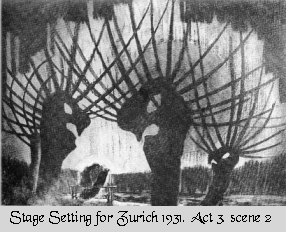"The function of a composer is to solve the problems of an ideal stage director" wrote Alban Berg in 1927. "My intention was to give to the theatre what belongs to the theatre. ….. "No one in the audience, no matter how aware he may be of the musical form….. gives any heed to anything but the vast social implications of the work which transcend by far the personal destiny of Wozzeck. This, I believe, is my accomplishment."
Click here to my review of Berg Wozzeck at the Royal Opera House, 2013.
Berg knew the technical limitations of stagecraft in his time, but he also knew that, in Wozzeck, he had written something radical that transcended time. For him the opera’s message was paramount : his aim was to confront the audience and make it think. This most cerebral of operas received perhaps its most intuitive interpretation in the groundbreaking Keith Warner production at Covent Garden in 2002, of which is being revived this season. The original production was controversial because it was so thought provoking and challenging. In the last few years its been discussed so often that its insights are now better understood, and the opera’s multi level complexity even more appreciated. Matthias Goerne, a veteran of four major productions of Wozzeck prior to 2002, and a man passionately intrigued by the opera, created the idea of Wozzeck floating lifeless in the glass cube near the end. It was, as Warner said at the time, a flash of inspiration no director would dream of suggesting. It expresses Berg’s central beliefs so vividly that any new solution to the staging will be haunted by the idea of Wozzeck silently confronting the audience, forcing them to address their complacency.
For who is Wozzeck ? is he no more than a PTSD squaddie who kills his partner, as in the ENO Wozzeck, a piece of blatant Über-Regie which delighted audiences because it neutralized the darker implications of the story. Or is he just a pawn in a wider game, as Berg suggests ? Wozzeck's not even an anti-hero, but a hapless lout who kills because he can't think articulately. But who are the real villains ? Berg knew about military organizations (and hospitals) from first hand experience. He didn't admire authoritarian systems. Note how the Doctor wails "O, meine Theorie!". His crackpot theories override science, logic and common sense but no-one questions. Theory above reality! Classic sign of obsessive compulsive disorder, which Berg himself might have suffered from to some extent. All that numerology and those cryptic mazes....;but Berg was "sane" because he could see where real evil lay..
Keith Warner's Wozzeck at the Royal Opera House tonight, is infinitely more perceptive. The stage is clinical, oppressive lights and sterile surfaces. Glass cases contain relics of "normal" life. Wozzeck's visions of mushrooms and organic matter thus take on greater significance. Here life is neutralized. The Doctor is a control freak whom no-one questions. The Captain is his enforcer, the men of the garrison fodder for the Doctor's experiments. Thus the Drum Major becomes a symbol of rude, vivid life though he's uncouth. Marie fancies him as a way out of her dreary existence. Wozzeck, trapped on all sides, can only react with violence.
The influence of film on Berg's music can't be under estimated. The Doctor may have origins in The Cabinet of Doctor Caligari (1921) where "madness" must be locked up. But who is the madman - doctor or patient ? When Wozzeck drowns in the lake, many productions depict the scene in red, as Berg suggested, in line with the idea of blood which runs through the opera. On the other hand, Berg was not dogmatic, and in any case, blood no longer flows in Wozzeck and Marie because they are dead. It's enough that the moon is red, and the wate rin the tank is, too. Naturalism isn't essential, as the photo above shows. It's the 1931 production where the set show stylized trees, with "human" faces. The Doctor and the Captain hear Wozzeck's last struggles for life, but deliberately refuse to acknowledge any reality other than their own. In Warner's production, Wozzeck becomes another exhibit in the Doctor's mad scientist laboratory. He floats, apparently lifeless like an embryo in amniotic fluid. It's a powerful metaphor, and also links to the Child, and to Berg's penchant for symmetry.At the premiere, few knew how the effect was created, so felt horrifyingly dangerous - as so it should ! Wozzeck should not offer comfort.
Wozzeck is an excellent choice for Halloween. And like the festival, it's a lot more subversive than you'd think.




+COOPER-1.jpg)


+COOPER-2.jpg)

